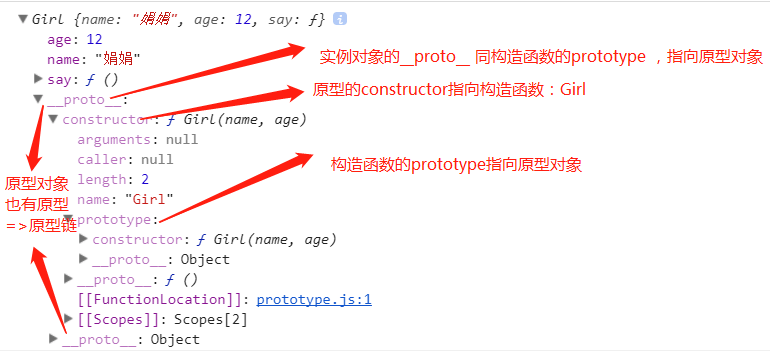
No more than code.
面向对象( Object-Oriented OO )
Javascript 中创建对象方式:
var girl = new Object();
girl.name = '小美';
girl.age = '18';
var girl = {
name: '小美',
age: '18',
};
若创建一个对象,上面两种方法很简单,但若创建多个具有相同属性的对象,就要把相同的代码重复 n 次。对于强迫症(懒)的童鞋恐怕就要烦躁了。因此想到了封装,也就是常说的工厂模式。
function girl(name, age) {
var obj = new Object();
obj.name = name;
obj.age = age;
return obj;
}
var girl1 = girl('easy1', 20);
var girl2 = girl('easy2', 20);
构造函数与普通函数区别在于调用方法。对于任意函数,使用 new 操作符调用,那么它就是构造函数。
function Girl(name, age) {
this.name = name;
this.age = age;
this.say = function () {
console.log('我叫' + this.name + ',今年' + this.age + '岁!');
};
}
const girl1 = new Girl('娟娟', 12);
const girl2 = new Girl('莉莉', 18);
通过构造函数创建实例时,每创建一个实例,都要重新创建一个 say 方法,无疑造成了很大的浪费。
原型对象用来存放实例中共有的属性和方法。
构造函数拥有一个 prototype 属性,指向原型对象。原型对象拥有一个 constructor 属性,指向构造函数(构造函数/原型对象==互指关系)。

function Girl(name, age) {
this.name = name;
this.age = age;
}
Girl.prototype.say = function () {
console.log('我叫' + this.name + ',今年' + this.age + '岁!');
};
//通过这个构造函数创建实例并调用say方法:
const girl1 = new Girl('娟娟', 12);
const girl2 = new Girl('莉莉', 18);
girl1.say(); // 我叫娟娟,今年12岁!
girl2.say(); // 我叫莉莉,今年18岁!
//重写girl2 say方法:
girl2.say = function () {
console.log(this.name + '我今年' + this.age + '岁啦!');
};
girl1.say(); // 我叫娟娟,今年12岁!
girl2.say(); // 莉莉我今年18岁啦!
每个实例可以重写原型中已经存在的属性来覆盖这个属性,并且不会影响到其他的实例。
如果想要统一修改所有实例继承的属性,只需要直接修改原型对象中的属性即可。
Girl.prototype.say = function () {
console.log(this.name + '的say方法:原型方法重写');
};
girl1.say(); // 娟娟的say方法:原型方法重写
girl2.say(); // 莉莉我今年18岁啦!
JavaScript 中所有的对象都是由它的原型对象继承而来。而原型对象自身也是一个对象,它也有自己的原型对象,这样层层上溯,就形成了一个类似链表的结构(顶级 null),这就是原型链(prototype chain)。
- 访问对象的属性时,JavaScript 会首先在对象自身的属性内查找,若没有找到,则会跳转到该对象的原型对象中查找。
通过原型链可以在 JavaScript 中实现继承。
子类原型直接引用父类:Children.prototype = Parent.prototype
function Parent(name) {
this.name = name;
}
Parent.prototype.say = function () {
console.log('Hello, ' + this.name + '!');
};
function Children(name) {
this.name = name;
}
Children.prototype = Parent.prototype; //子父类原型引用同一个对象
Children.prototype.say = function () {
//修改子类prototype也会影响父类原型
console.log('Hello, ' + this.name + '! hoo~~');
};
var parent = new Parent('父类');
var children = new Children('子类');
parent.say(); // "Hello, 父类! hoo~~"
children.say(); // "Hello, 子类! hoo~~"
子类原型间接引用父类
function Parent(name) {
this.name = name;
}
Parent.prototype.say = function () {
console.log('Hello, ' + this.name + '!');
};
function Children(name) {
this.name = name;
}
//<!-- children 和 parent 的属性相同,可以使用apply
//function Children(name){
//Parent.apply(this, arguments);
//} -->
//方式1
function F() {} // empty
F.prototype = Parent.prototype;
Children.prototype = new F();
//方式2 ES5
Children.prototype = Object.create(Parent.prototype);
var parent = new Parent('父类');
var children = new Children('子类');
parent.say(); //"Hello, 父类!"
children.say(); //"Hello, 子类!"
确定原型和实例之间的关系:
- 实例 instanceof 原型 //true or false
- 原型.prototype.isPrototypeOf(实例) //true or false
call
apply
bind
var xw = {
name: '小王',
gender: '男',
age: 24,
say: function (school, grade) {
alert(`${this.name},${this.gender},今年${this.age},在${school}上${grade}`);
},
};
var xh = {
name: '小红',
gender: '女',
age: 18,
};
xw.say.call(xh, '实验小学', '六年级');
xw.say.apply(xh, ['实验小学', '六年级']);
xw.say.bind(xh)('实验小学', '六年级')();
总结:
- 共同点:call()、apply()和 bind()都是用来改变函数执行时的上下文,可借助它们实现继承;如果第一个参数不传,或者第一个传递的是 null/undefined,在 非严格模式下,this 指向 window;在 严格模式下,this 为 undefined
- call()和 apply()唯一区别是参数不一样,call()是 apply()的语法糖;
- bind()是返回一个新函数,供以后调用,而 apply()和 call()是立即调用。
如何选用:
- 如果不需要关心具体有多少参数被传入函数,选用 apply();
- 如果确定函数可接收多少个参数,并且想一目了然表达形参和实参的对应关系,用 call();
- 如果我们想要将来再调用方法,不需立即得到函数返回结果,则使用 bind();
// 重写 call
((proto) => {
function myCall(thisArg, ...args) {
thisArg = thisArg == undefined ? window : thisArg;
let type = typeof thisArg;
if (!/^(object|function)$/.test(type)) {
if (/^(symbol|bigint)$/) {
thisArg = Object(thisArg);
} else {
thisArg = new thisArg.constructor(thisArg);
}
}
let key = Symbol('key');
thisArg[key] = this;
let result = thisArg[key](...args);
delete thisArg[key];
return result;
}
proto.myCall = myCall;
})(Function.prototype);
// 重写 apply
(proto => {
function myApply(thisArg, args) {
thisArg = thisArg == undefined ? window : thisArg;
let type = typeof thisArg;
if (!/^(object|function)$/.test(type)) {
if (/^(symbol|bigint)$/) {
thisArg = Object(thisArg);
} else {
thisArg = new thisArg.constructor(thisArg);
}
}
let key = Symbol('key');
thisArg[key] = this;
let result = thisArg[key](...args);
delete thisArg[key];
return result;
}
proto.myApply = myApply;
})(Function.prototype)
// 重写 bind
(proto) => {
function myBind(thisArg, ...args) {
let _this = this;
thisArg = thisArg == undefined ? window : thisArg;
let type = typeof thisArg;
if (!/^(object|function)$/.test(type)) {
if (/^(symbol|bigint)$/) {
thisArg = Object(thisArg);
} else {
thisArg = new thisArg.constructor(thisArg);
}
}
return function an(...innerArgs) {
_this.call(thisArg, ...args.concat(innerArgs));
};
}
proto.myBind = myBind;
})(Function.prototype);
// 重写 new
function Dog(name) {
this.name = name;
}
Dog.prototype.bark = function () {
console.log('wangwang');
}
Dog.prototype.sayName = function () {
console.log('my name is ' + this.name);
}
//==========重写开始
function _new(Func, ...args) {
let obj = Object.create(Func.prototype);
let result = Func.call(obj, ...args);
if (result !== null && /^(object|function)$/.test(typeof result)) return result;
return obj;
}
//==========重写结束
let sanmao = _new(Dog, '三毛');
sanmao.bark(); //=>"wangwang"
sanmao.sayName(); //=>"my name is 三毛"
console.log(sanmao instanceof Dog); //=>true